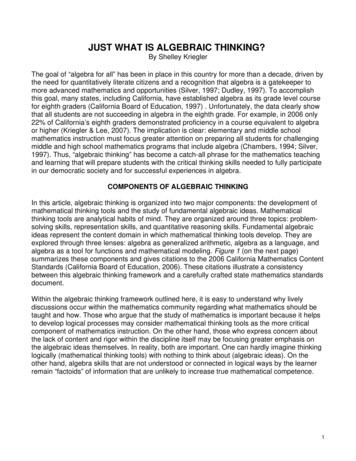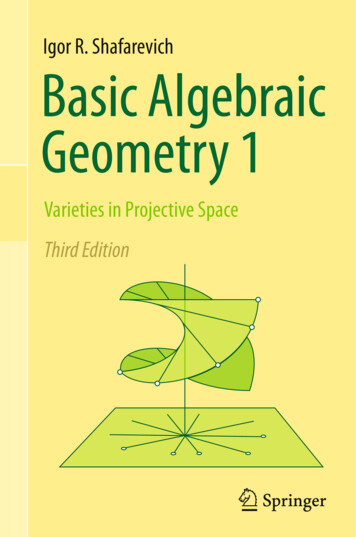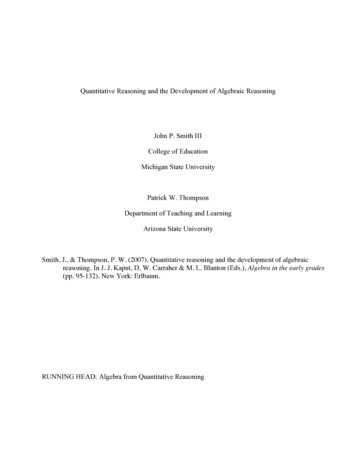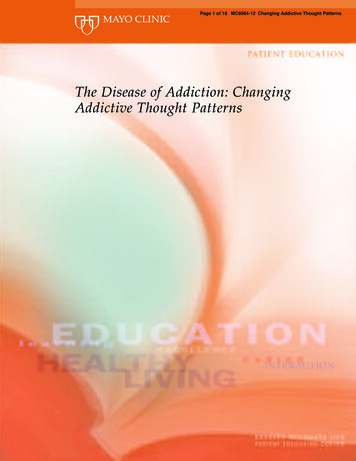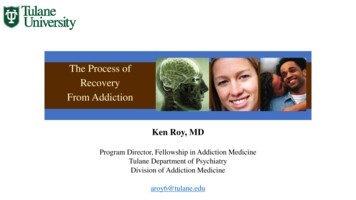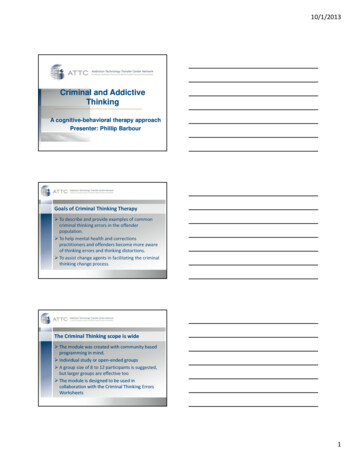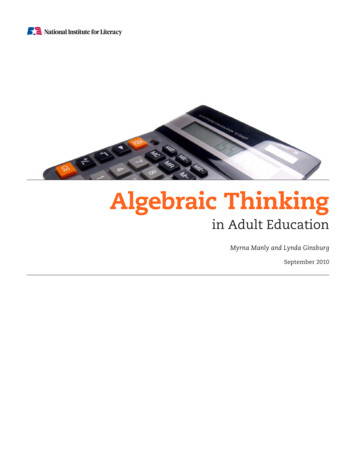
Transcription
Algebraic Thinkingin Adult EducationMyrna Manly and Lynda GinsburgSeptember 2010
This report was produced under National Institute for Literacy Contract No.ED-04-CO-0121/0002 with MPR Associates Inc. It was written by Myrna Manly,Numeracy Consultant, and Lynda Ginsburg, Senior Research Associate forMathematics Education, Center for Mathematics, Science and ComputerEducation, Rutgers University. Lynn Reddy served as the contracting officer’srepresentative. The views expressed herein do not necessarily representthe positions or policies of the National Institute for Literacy. No officialendorsement by the National Institute for Literacy of any product, commodity,or enterprise in this publication is intended or should be inferred.For quality assurance purposes, drafts of publications commissionedby the National Institute for Literacy are subjected to a rigorousexternal peer review process by independent experts. This reviewprocess seeks to ensure that each report is impartial and objectiveand that the findings are supported by scientific research.The National Institute for Literacy, a Federal government agency,is a catalyst for advancing a comprehensive literacy agenda. TheInstitute bridges policy, research and practice to prompt action anddeepen public understanding of literacy as a national asset.Daniel Miller, Acting DirectorLynn Reddy, Deputy DirectorSeptember 2010The citation for this report should be: National Institute for Literacy,Algebraic Thinking in Adult Education, Washington, DC 20006
Table of ContentsIntroduction . . . . . . . . . . . . . . . . . . . . . . . . . . . . . . . . . . . 1Why Should Algebra beIncluded in Adult Education? . . . . . . . . . . . . . . . . . . . . . 2What Does Recent ScholarshipSay About Algebra? . . . . . . . . . . . . . . . . . . . . . . . . . . . . . 4Mathematics Instructionin Adult Education Today . . . . . . . . . . . . . . . . . . . . . . . . 7Revising Mathematics Instructionin Adult Education . . . . . . . . . . . . . . . . . . . . . . . . . . . . . . 8Supporting Classroom Practice . . . . . . . . . . . . . . . . . . 12What Research Would Contributeto this Discussion? . . . . . . . . . . . . . . . . . . . . . . . . . . . . . 12Summary . . . . . . . . . . . . . . . . . . . . . . . . . . . . . . . . . . . . . 13Bibliography . . . . . . . . . . . . . . . . . . . . . . . . . . . . . . . . . . 13
Algebraic Thinking in Adult EducationIntroductionA world where employers “will be looking for the mostcompetent, creative, and most innovative” workers ispredicted in Tough Choices or Tough Times, a report bythe New Commission on the Skills of the AmericanWorkforce (2006). The report notes as well that literacy inwhich “mathematical reasoning will be no less importantthan facts” is critical not only for top professionals, butalso for those at all skill levels in the workforce. As moreindustries adopt new technologies, a solid understandingof mathematics and science will be needed to realize thefull potential of these technologies in new situations.Industries such as biotechnology, geospatial, healthcare, financial services and the skilled trades “can’t findenough workers with the right skills for these high-skilled,good-paying jobs” (U.S. Department of Labor 2005).These are examples of industries that need employees withmathematical knowledge and skills. The greatest rewardswill go to those who are comfortable with ideas and abstractions, can adapt flexibly to changes, and can generalizeand synthesize.What kind of mathematics instruction for adultswould enable them to meet the demands of this predictedfuture? Conceptual understanding and problem-solvingability are critical proficiencies that should be the cornerstones of a revised set of basic skills. Further, this paperproposes that algebraic reasoning, a way of thinking that reflects the core skills and underlying principles supportingnumber relationships and operations, be integrated earlyinto all levels of arithmetic instruction. Although there arevarious conceptions of algebraic thinking in the field, inthis paper we use the term to mean thinking that involves looking for structure (patterns and regularities) tomake sense of situations generalizing beyond the specific by using symbolsfor variable quantities representing relationships systematically withtables, graphs, and equations reasoning logically to address/solve new problemsProviding opportunities to generalize the relationshipsand properties of arithmetic at an early stage of learningincreases students’ chance for success in a formal algebraclass. Further, algebraic reasoning gives a logical coherenceto arithmetic procedures, which are often perceived to bearbitrary and incoherent.We also propose that formal algebra instruction foradults emphasize modeling (analyzing and representingreal situations with mathematical structures), which isfundamental to applying mathematical concepts to everyday life and workplace situations. We believe that thisapproach is tailor-made for adult students.Both the K–12 and adult education systems alreadyhave begun to take steps to integrate algebraic reasoningat all levels. For K–12 instruction, the National Councilof Teachers of Mathematics (NCTM) published a list(NCTM 2006) of focal points for mastery at each gradelevel from kindergarten to eighth grade, including an earlyalgebra strand emphasizing recognition of the propertiesof the numbers and operations students are learning. Atthe adult level, there is a new focus on preparing for postsecondary education and the training required for jobs inhigh-growth, high-demand industries. In their new adultmathematics standards, many states recommend introducing algebraic thinking and data analysis to learners at alllevels. And some go beyond the traditional goal of passingthe GED (General Educational Development) test by offering programs that assist students in their transition tocommunity college or vocational training.Why is Algebra Importantin Adult Education?Mathematics proficiency is needed to satisfy formal academic requirements for advancement as well as to meetthe genuine skill demands of home and work. “It’s themath that’s killing us,” notes Dr. Donna McKusik, director of developmental education at the Community Collegeof Baltimore County, referring to the many entering students with test scores indicating that they need to pass ahigh-school-level algebra course to proceed toward theircareer goals. She observes that the course is a real stumbling block for many; they lose confidence, dropping outnot just of math class but also of college, even though theirskills in other subjects are up to par (Schemo, New YorkTimes, Sept. 2, 2006).1
National Institute for LiteracyEven among those who have finished college and arestarting their careers, there is a sobering lack of practicalmathematical ability. According to the National Surveyof America’s College Students (American Institutes forResearch 2006), which assessed prose, document, andquantitative literacy, graduating college students struggledmost with quantitative literacy. In fact, 30 percent of students earning two-year degrees and 20 percent of thoseearning four-year degrees have only basic quantitativeliteracy skills. These students were unable to completesuch tasks as calculating the total cost of office supplies orestimating whether their car has enough gas left to make itto the next gas station.Solid mathematical skills and understanding areessential in virtually all aspects of life, and they are formal requirements in many of the roles adults play. Thefollowing examples illustrate the use of —and need for—algebra in everyday situations, formal education, and theworkplace.Personal Financial Literacy and Decision MakingFull participation in today’s society involves a genuinegrasp of the mathematical concepts that studying algebraprovides. Quantitative demands can be both complex andpervasive, reaching into an individual’s daily life as citizen,worker, parent, and consumer. Often it is the big ideasof algebra, not the procedural details, which people drawupon when making wise decisions.For example, the concept that change often occursover time according to predictable patterns based onmathematical relationships is a valuable tool for decisionmaking. A young person who understands the power ofcompounding (i.e., the shape of the graph of exponentialgrowth) when saving and investing may be more likely torestrict spending and begin saving at an early age to buildlifetime assets. More important, those who recognize thepainful side of compounding can avoid building up creditcard debt, as interest charges are compounded and debtquickly grows to high levels. To be clear, although theskills and procedures of algebra are important, it is oftenthe more sophisticated understanding of mathematicalrelationships imparted by algebra that is useful in navigating life’s decision-making challenges.2Academic RequirementsCompleting an algebra course is often a credentialing requirement, a hurdle to jump on the way to further study.Adult students first meet the formal requirement foralgebra in their preparation for the GED test, the goal ofmany who come to adult education classes. Since one oroften two courses in algebra are included in requirementsfor high school graduation in many states, algebra also isincluded on the GED mathematics test. The next algebrahurdle appears when students take college mathematicsplacement tests. At least one year of algebra is required forstudents intending to pursue most two-year technical certificates or degrees, as well as for those planning to transferto a four-year college.Students not sufficiently proficient in mathematics toproceed to college-level course work are required to enrollin courses at the high school, or even middle school, leveloffered as developmental courses. At most colleges, a developmental algebra class “covers” a full year of high schoolalgebra in one semester and typically does not carry collegecredit. As a result, 57 percent of two-year college studentstake (and often repeat) mathematics courses withoutgaining any college credits (Lutzer et al. 2007). Thesestudents pay college tuition for courses offered free in highschool (and free or for a nominal fee in adult educationprograms). Even more distressing is the fact that many ofthese students deplete their financial aid in developmentalcourses. One study found that only one-quarter of thosereferred to a sequence of developmental classes had successfully completed them by the end of their third year(Clery 2006).Entrance-to-Employment RequirementsThe formal entrance requirements for careers in manyhigh-growth industries include at least an associate’s degree. The 50 fastest-growing occupations from 2006-2016(http://www.careerinfonet.org) include only 12 occupations that do not require postsecondary certificatesor degrees. (Preparation for these occupations involvesvarious levels of on-the-job training.) All but one of these12 non-degree occupations (gaming managers) were inthe lower two quartiles of earnings, which translates to anannual salary of less than 28,570, less than the incomenecessary to support a family in most parts of the country.
Algebraic Thinking in Adult EducationThis trend can also be seen by examining the 50 occupations with declining employment from 2006–2016(http://www.careerinfonet.org). Most of these occupations (47 out of 50) require “on-the-job training.”Clearly, satisfactory employment opportunities are likelyto be even more limited than in previous years for thosewho have not demonstrated competence in algebra, a requirement for a post secondary certificate or degree.On-the-Job RequirementsThe benefits of studying algebra are sometimes subtle. Inthe workplace, workers often are not aware when theyuse an overarching mathematical concept. For example,researchers have shown that the concept of proportionality was applied in nearly every workplace they studied(Hoyles et al. 2002; Marr and Hagston 2007; Selden andSelden 2001). Nurses use proportionality when determining the correct dose of medication, and cosmetologists useit when mixing solutions, but few recognize that they areusing “school math” because the mathematical ideas are sodeeply embedded into the context of the job. Adults oftensay they have never used the algebra they learned in school.That may be true for the rote aspects of manipulating symbols, but they likely are using the mathematical reasoningand problem-solving aspects of algebra unconsciously.Technological advances affect the mathematics required in the workplace in different ways. On the onehand, computers have lessened the requirements forworkers themselves to be precise in routine work, be itcalculations in clerical positions or measurement on an assembly line. Digital devices also perform monitoring tasks,assessing and graphing the state or quality of a process. Onthe other hand, mathematical requirements have increasedbecause workers need to be comfortable using these devices and monitoring the outcomes.Selden and Selden (2001) describe how the proliferation of graphical data has created specific demandsinvolving the algebraic topic of graphing with rectangularcoordinates. Management information, formerly the domain of higher-level workers, must now be interpreted bythose who work “on the line.” This is true in many jobs,from home health aides to factory production workers.Workers need to understand the relationship between theconventional aspects of Cartesian graphing (e.g., points,slopes, intercepts, intersections) and how to reason withinthat abstract system, so they can recognize what the graphsrepresent in the real context. For example, a steep line indicates a rapid change in whatever is being tracked, and thecontext determines if this change is normal or abnormal.Office workers and production workers alike need torecognize out-of-whack results before they are disseminated. Using spreadsheets to make calculations with largeamounts of data eliminates the need to do the task byhand, but also increases the impact of one mistake. Whilethe need for precise paper-and-pencil calculation on thejob may have decreased with the onset of automatedsystems, the ability to estimate reasonable answers hasbecome more valuable in checking for errors that couldhave widespread effects.The ability to write a mathematical expression or algebraic equation so that a software program will handledata as one intends is also critical. Creating and adjusting an abstract model requires deeper understanding ofmathematical relationships, not just the ability to dealwith the details of a specific example. Algebraic reasoningwith symbols is needed to determine the equivalence ofvarious expressions that could be used as the formula fora certain operation in a spreadsheet. For example, a 5 percent increase in a quantity (x) could be entered as x .05xor as 1.05x.The ability to remain flexible in the methods used forcomputation allows workers to adapt to new requirements. Researchers such as Noss, Hoyles and Pozzi(2000) and Scribner (1984) have noted that workersused “idiosyncratic” methods for computing in the workplace and passed them on to new workers. Their inventedmethods were effective in specific situations and easierfor them than the formal procedures learned in school.Although they may not have understood the principlesthat made their invented methods work, they couldrecognize consistent patterns and devise a method fortheir situation. When changes occur in the workplace,however, workers must have sufficient understandingto be able to re-evaluate their method to see if it is stillappropriate and devise a different method if necessary.Flexible thinking, not mindless adherence to a procedure,is required in such situations.3
National Institute for LiteracyRecent Scholarship about AlgebraThe research described here is based on work with children. Currently, there is no comparable body of researchfor adults. Based on our years of teaching mathematicsto adults in various settings and our experience in assessment and research, we are extrapolating from the existingresearch, which we believe provides insight into algebrateaching and learning for adults. Schmitt (2003) has observed that adults who are returning to mathematics study“possess some, but never all, of the characteristics of themore frequently studied groups” (p. 67).Various researchers have offered different descriptions of algebra. For example, Usiskin (1995) stated thatalgebra uses symbolic language to describe real and hypothetical patterns and includes generalized arithmetic,a means to solve problems, the study of relationships,and the study of mathematical structures. Romberg andSpence (1995) stressed that “algebra is a tool for making sense of the world — for making predictions and formaking inferences about things that you cannot measureor count” (p. 186).James Kaput (2007) has offered a conceptualizationthat includes three strands of algebra within which theprocesses of generalizing and conventional symbol manipulation occur:1. Generalizing arithmetic and quantitative reasoning,with particular emphasis on symbols, expressions,and equations;2. Studying functions, relations, and joint variation,with the use of a wide range of representations,including equations, tables, graphs and “variouspedagogical systems such as ‘function machines’”(p. 14); and3. Using modeling to generalize and express patternsor regularities in situations from within or outsideof mathematics or to move from specific examplesto more general forms that highlight relationships.The predominant content and instructional approachescurrent in school algebra courses in the United Statesprioritize different aspects of Kaput’s components. Kieran(2007) describes “traditional” programs as having a strongsymbolic orientation and focus on developing formal4procedures to simplify and manipulate expressions, equations, inequalities, systems of equations, and polynomials.The emphasis is on recognizing forms and masteringtransformational processes. Reform-oriented programsemphasize the study of functions, using letters to representvariables and equations to describe real-world situations oractivities. Algebraic notation and various representationsare used to describe how quantities vary with each otherand depend on each other. Algebraic procedures are usedto operate within the mathematical system, but they donot define it.Definitive research on how algebra is best learnedand taught is not available, and research on differentapproaches has been varied and sometimes contradictory (National Mathematics Advisory Panel 2008). Ina year-long qualitative research study, however, Chazan(2000) found that instruction emphasizing functionswas particularly engaging and meaningful for at-risk highschool students. Similarly, the modeling approach thatemerges from experiential learning has been used by theAlgebra Project and found to be accessible and effectivefor African-American children who might otherwise bemarginalized (Davis et al. 2007; Moses and Cobb 2001).These findings suggest that it might be fruitful to employ amodeling/functions approach with adult learners, as theyresemble the populations in these studies.Problematic Algebraic ConceptsNumerous research studies have examined common aspects of each of the strands that have consistently causedstudents difficulty, with some consensus emerging on themechanisms that contribute to the difficulties. Below wesummarize some of the findings related to three algebraic“big ideas,” or concepts, that may be especially consequential for enhancing adult algebra learning: variable, symbolicnotation, and multiple representations.Variable. The notion of “variable” is of primary importancein algebra, as it forms the basis of generalizations. Researchhas identified reasons why students have difficulty understanding and using variables. When adult educationinstructors understand, look for, and recognize these problems, they can begin to help students overcome them.
Algebraic Thinking in Adult EducationStudents have difficulty discriminating among the different ways letters may be used. First, in arithmetic lettersare first encountered in formulas (for example,), which aregenerally provided as procedural guides. The student isasked to substitute the appropriate quantities to determinethe perimeter, area, or volume. Letters in the formulas areactually variables, but they are rarely discussed as such.Second, a letter can represent a specific number that iscurrently unknown but should be determined or “found”(e.g., ). Third, a letter can represent a general number(such as), which is not one particular value. Finally, letterscan represent variables (such as in), each of which represents a range of unspecified values along with a systematicrelationship among them (Kieran 1992, p. 396). Teachersmay assume that students can easily navigate among thesedifferent uses and meaning of letters, but interviews withadult students indicate this is not necessarily so (Jacksonand Ginsburg 2008). Understanding the use of variables iscrucial for students’ success in algebra.Some students have been found to believe that lettersrepresent particular objects or abbreviated words becauseof their alphabetic connection (e.g., that represents “threedogs”) or that a letter is a general referent (John’s heightis 10 inches more than Steve’s height: ) (MacGregor andStacey 1997). Again, teachers need to pay close attentionto such errors.Symbolic notation. Some students have difficulty understanding that some of the symbolic notation familiar fromarithmetic has different meanings and uses in algebra.Again, while the research studies were conducted withchildren and teens, the patterns of performance are similarfor adult learners, and the findings can inform adult algebra instruction.In arithmetic, the equal sign is commonly seen whenthe task requires a numeric operation, as in 4 8 .Many students perceive that the equal sign should be read,“And the answer is .” In algebra, the symbol represents equivalence between two expressions (as in ); equality(as in ); or a functional relationship (as in ). When the equalsign is perceived as signifying a symmetric balance betweentwo quantities (on either side of the sign), then the needto perform the same operation on both sides of the equation becomes meaningful. Students’ success in solvingequivalent equation problems has been found to be relatedto the sophistication of their understanding of the relational aspect of the equal sign (Alibali et al. 2007; Knuthet al. 2006; Rojano 2002 ).Other common mathematical symbols differ in use andmeaning in arithmetic and algebraic contexts, and somestudents have difficulty discriminating between them. Forexample, the plus ( ) and minus (–) symbols signify executable operations (addition, subtraction) in arithmetic,but they also indicate negative and positive numbers aswell as operations in algebra (Gallardo 2002; Keiran 1992;Vlassis 2004; as cited in Kieran 2007).Multiple representations. Multiple representations are usedto describe, understand, and communicate generalizationsalgebraically. These include symbols, tables, graphs, andverbal descriptions. The perceptual aspects of different representations have an impact on students’ reasoning. Thereare developmental trajectories for the different representations, with intuitive knowledge and previous experiencescontributing to understanding (Brenner et al. 1997; Friel,Curcio and Bright 2001; Nathan and Kim 2007; Swaffordand Langrall 2000). Each representation has its benefitsand limitations, requiring a consideration of their tradeoffs when deciding their appropriateness for the task athand. Often, representations are addressed separately during instruction, with an extended unit focused on symbolmanipulation, a separate unit on patterns and tables, anda further unit on graphing. Students perceive that thedifferent representations reflect separate and unrelatedprocedures and content. One of the goals of algebra instruction is to provide students with experiences that willenable them to make connections among the different representations and build flexibility in moving across them.Introducing Elements ofAlgebra Instruction EarlyIn response to students’ difficulties transitioning fromarithmetic to algebra when the two subjects are disconnected by time and content, K–12 educators have begunintegrating algebraic ideas and representations into alllevels of arithmetic learning, thus encouraging the gradualdevelopment of algebraic reasoning. Researchers have explored the development of algebraic reasoning in younger5
National Institute for Literacystudents still learning arithmetic and have found that theycan reason algebraically and that algebraic work may evenfacilitate their understanding of arithmetic (Carpenterand Franke 2001; Schifter 1999). Reform mathematicscurricula, developed over the last 20 years and implemented widely over the last 10 years, all integrate algebrathroughout the grades, following the lead of the NationalCouncil of Teachers of Mathematics standards (1989,2000), among others. These curricula generally include afunctions approach, relying heavily on modeling real workevents or activities.The What Works Clearinghouse (WWC) used astandard of rigorous methodology to examine numerousreports and studies of curriculum interventions to see ifclaims of effectiveness were supported. Of particular interest is the performance of groups of students using one ofthe reform curricula compared with that of control groupsusing traditional curricula.For elementary-school math, WWC (2007a) examined 237 intervention studies and found 9 studiesof 5 curricula that met its methodological criteria. Onecurriculum, Everyday Mathematics, was found to havepotentially positive effects on mathematics achievement,with no overriding contrary evidence. Among the featuresof this program is a continuous strand of algebra fromkindergarten through sixth grade, intertwined with othercontent. For example, in fourth through sixth grades,the topics include patterns, sequences, and functions;functions and multiple representations; solving numbersentences by algebraic manipulations; grouping symbolsand order of operations; simplifying expressions; and proportion (The University of Chicago School MathematicsProject 2004).At the middle-school level, defined as grades 6 through9, the WWC (2007b) found 21 studies of 7 curricula thatmet its standards. Five curricula showed positive or potentially positive effects. The WWC notes that one of theseprograms, the University of Chicago School MathematicsProject (UCSMP Algebra), “highlights applications, usesstatistics and geometry to develop the algebra of linearequations and inequalities. [and] emphasizes graphing,while manipulation with rational algebraic expressions isdelayed until later courses” (WWC 2007b, p. 1).6These findings indicate that integrating elements ofalgebra while children are learning arithmetic is effective inpromoting positive learning outcomes. Algebra curriculathat focus primarily not on symbol manipulation, butrather on multiple representations and a functional approach have also proven effective. Although these studieswere not conducted with adults, they provide a basis forreconceptualizing how algebra might be taught to enhancethe development of adults’ algebraic reasoning.This approach seems particularly salient as a way ofameliorating adults’ difficulties in making the transitionfrom arithmetic to algebra. Adults returning to schoolarrive with patchy knowledge, varied experience studyingmathematics and algebra, and limited time to participatein education. Putting off encountering algebra until theymaster all arithmetic content often means that adults areeffectively excluded from studying algebra.Mathematics Instruction inAdult Education TodayPresently, the goal of most mathematics instruction in atypical adult education program is students’ acquisitionof the ability to complete arithmetic procedures withwhole numbers, fractions, decimals, and percents on paperwithout error (Schmitt 2000). It seems to be generallyaccepted that a certain level of skill with these proceduresmust be attained before any real applications or algebraicconcepts can be understood. This sequence is reinforcedby most materials published for use in adult education andby the most common tests used to assess student progress.Studying algebra is usually delayed until the finalstages of preparation for the GED math test. Algebra isassumed to be difficult and taught as if it were completelyirrelevant to real life or to any prior mathematics learning. Thus, algebra is generally approached with a greatdeal of anxiety by students and teachers alike. GED-prepalgebra instruction tends to focus on elementary topics ofsymbol manipulation, simplifying expressions, and solvingequations. This “quick fix” approach relies on memorizing sequences of steps and does not present a coherentpicture. Students seldom gain the conceptual understanding and reasoning ability needed for the successfulpursuit of further goals. Not surprisingly, this minimalinstruction also is not sufficient to permit students to
Algebraic Thinking in Adult Educationopt out of developmental courses in community collegeswhen they take placement tests (e.g., ACCUPLACER,COMPASS).Adult high school, adult diploma, and external diploma programs offer full-credit high school algebracourses. Students receive credit for the courses andmust also pass the state high school exit exams to earna diploma. Many teachers for these courses are
proposes that algebraic reasoning, a way of thinking that re - . quantitative literacy, graduating college students struggled most with quantitative literacy. In fact, 30 percent of stu - . bols, but they likely are using the mathema
